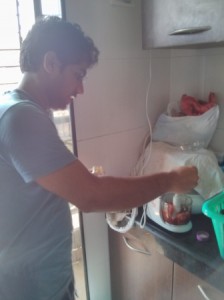Aditi & I have forever been crazy fans of mashed potatoes. I hadn’t cooked anything on the flame other than maggi before (don’t go by the order of posts here) and a (part-successful) attempt at roti prata (aka roti canai). Aditi was out for work on a weekend and I thought of trying this out as it needs very few ingredients. Most indian households will have all of this. Check: oven, baking dish and cream.
Ingredients:

- 4-5 Potatoes50 grams butter or fat spread
- Processed or soft Cheese (optional)
- 1/4th cup milk
- 2 tbsp cream
- 2 tsp Salt
- 2 tsp Pepper
- 2 tsp Chat Masala (to Indianize it)
- 2 tsp Oregano (optional)
Procedure:
1. Boil potatoes as usual, peel the cover and mash them
2. Pre-heat the oven at 170c. I used the convection function on my microwave
3. Add butter. I used Nutrella fat spread as its cholesterol free, tastes just like Amul butter and provides better binding
4. To keep the recipe low fat, I went easy on the cream, and used more milk instead
5. Grated cheese – processed or mozarella to make it thicker
6. Salt, pepper, chat masala & oregano and mix well to form a consistent mixture
7. Grease (apply butter) to the surface of the baking dish and pour the mixture in it. If you do not plan to eat it right away, apply shrink-wrap to the dish and refrigerate.
8. Bake in the oven for about 40mins at 170c, or until the surface changes color.
9. If you’re making this for your wife or mother, make sure you return the platform spick-n-span 🙂














